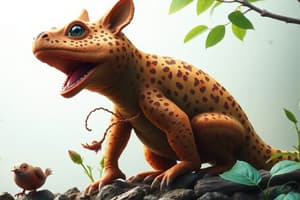Podcast
Questions and Answers
Which of the following sequences correctly orders the ecological levels of organization from simplest to most complex?
Which of the following sequences correctly orders the ecological levels of organization from simplest to most complex?
- Community, Population, Organism, Ecosystem, Biosphere
- Organism, Community, Population, Ecosystem, Biosphere
- Organism, Population, Community, Ecosystem, Biosphere (correct)
- Biosphere, Ecosystem, Community, Population, Organism
Which of the following is the most accurate representation of how energy flows through a simple food chain?
Which of the following is the most accurate representation of how energy flows through a simple food chain?
- Primary Consumer → Primary Producer → Tertiary Consumer → Secondary Consumer
- Primary Producer → Primary Consumer → Secondary Consumer → Tertiary Consumer (correct)
- Tertiary Consumer → Secondary Consumer → Primary Consumer → Primary Producer
- Secondary Consumer → Primary Producer → Primary Consumer → Tertiary Consumer
In the context of ecological productivity, what is the key difference between primary and secondary productivity?
In the context of ecological productivity, what is the key difference between primary and secondary productivity?
- Primary productivity measures energy loss in an ecosystem, while secondary productivity measures energy gain.
- Primary productivity is the rate of organic matter production by autotrophs, while secondary productivity is the rate of heterotroph conversion of consumed organic material. (correct)
- Primary productivity involves heterotrophs converting organic material, while secondary productivity involves autotrophs.
- Primary productivity focuses on energy transfer in aquatic ecosystems, while secondary productivity focuses on terrestrial ecosystems.
Which of the following statements accurately describes the role of gravity in supporting life on Earth?
Which of the following statements accurately describes the role of gravity in supporting life on Earth?
Which of the following best describes the relationship between Gross Primary Productivity (GPP), Net Primary Productivity (NPP), and Respiration (R) in an ecosystem?
Which of the following best describes the relationship between Gross Primary Productivity (GPP), Net Primary Productivity (NPP), and Respiration (R) in an ecosystem?
A researcher is studying a small, self-contained aquarium with plants, fish, and snails to understand basic ecological interactions. What type of experimental system is being used?
A researcher is studying a small, self-contained aquarium with plants, fish, and snails to understand basic ecological interactions. What type of experimental system is being used?
Which of the following is the correct sequence of the water cycle stages?
Which of the following is the correct sequence of the water cycle stages?
A diagram showing the flow of energy and nutrients between different organisms and non-living components within a forest ecosystem is an example of what kind of model?
A diagram showing the flow of energy and nutrients between different organisms and non-living components within a forest ecosystem is an example of what kind of model?
Flashcards
Ecology
Ecology
The study of relationships between living organisms, humans, and their physical environment.
Population
Population
A group of organisms of the same species living in a specific area.
Community
Community
All the different populations of species living and interacting in an area.
Ecosystem
Ecosystem
Signup and view all the flashcards
Biosphere
Biosphere
Signup and view all the flashcards
Food Chain
Food Chain
Signup and view all the flashcards
Food Web
Food Web
Signup and view all the flashcards
Primary productivity
Primary productivity
Signup and view all the flashcards
Study Notes
- Ecology studies the relationships between living organisms, including humans, and their physical environment.
Ecological Levels of Organization
- Organism
- Population
- Community
- Ecosystem
- Biosphere
Earth's Life Support System
- Lithosphere (land)
- Hydrosphere (water)
- Biosphere (living things)
- Atmosphere (air)
Earth System Science
- Atmosphere
- Geosphere
- Biosphere
- Hydrosphere
Solar Energy
- Energy from the Sun enables photosynthesis in plants.
- Photosynthesis provides oxygen and helps grow food.
Nutrient Cycle
- A system where energy and matter transfer between organisms and the environment's non-living parts.
Gravity
- The force that pulls objects to Earth.
- Without gravity, there would be no atmosphere.
Food Chains
- Linear sequences where nutrients and energy pass as one organism eats another.
Ecosystem Components
- Biotic (living)
- Non-biotic (non-living)
Stages of Food Chains
- Primary producers (autotrophs) like grass, algae, and phytoplankton use sunlight to make food.
- Primary consumers (herbivores) like grasshoppers eat grass.
- Secondary consumers (carnivores) like frogs eat grasshoppers.
- Tertiary consumers like snakes eat frogs.
- Quaternary consumers like eagles eat snakes.
- Food webs transfer energy within an ecosystem.
Ecological Productivity
- Primary fixation of solar energy by plants.
- Primary productivity is the rate at which autotrophs (plants, algae) produce organic matter through photosynthesis.
- Secondary productivity is the rate at which heterotrophs (animals) convert consumed organic material.
- Nutrient cycle rate at which heterotrophs (animals) convert organic material
Biosphere Components
- Plants
- Animals
- Fungi
- Protists
- Bacteria
- Archaea
Water Cycle Stages
- Evaporation
- Condensation
- Precipitation
- Infiltration
- Collection
- Run off
Conceptual Model
- Conceptual Models use flow charts to show the interactions between living and nonliving components of the ecosystem.
- Mesocosm is a controlled system replicating natural environments on a smaller scale.
- Microcosm is an artificial ecosystem simulating natural ecosystems under controlled conditions.
Productivity Equations
- Net Primary Productivity (NPP) is calculated as NPP = GPP - R.
- Net Secondary Productivity (NSP) is calculated as NSP = A - R.
- Gross Primary Productivity (GPP) is calculated as GPP = NPP + R.
- Gross Secondary Productivity (GSP) is calculated as GSP = I - F.
Studying That Suits You
Use AI to generate personalized quizzes and flashcards to suit your learning preferences.
Related Documents
Description
Explore the intricacies of ecology. This covers ecological levels of organization, Earth's life support systems, and the vital role of solar energy in photosynthesis. Understand nutrient cycles, gravity's importance, food chains, and biotic and abiotic ecosystem components.




